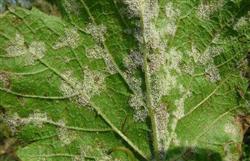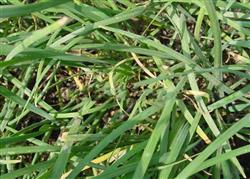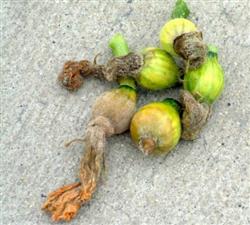Pumpkin planting: how to prevent and cure pumpkin Phytophthora?

How to prevent and cure pumpkin Phytophthora? Why does pumpkin Phytophthora occur? Please introduce that pumpkin Phytophthora is mainly caused by spring pumpkin, especially in rainy years, poor drainage and often causing large area rotten melon. The disease not only harms pumpkins, but also harms cucumbers, cucumbers, watermelons and so on, and often occurs mixed with Fusarium wilt. Pumpkin Phytophthora mainly overwintered in the soil with mycelia, oospores or chlamydospores, and became the primary infection source in the following year. Through irrigation, air flow, wind and rain to spread, seeds can also spread the disease, but the carrying rate is not high. Contact with the mycelium of the host, or spread to the host oocyte, chlamydospore germination directly through the epidermis into the host, causing pumpkin disease. Under wet conditions, sporangia can be produced on the disease spot, and the sporangium or its germinated zoospores can be re-infected by wind and rain, air flow and irrigation to spread the disease. Pumpkin Phytophthora can adapt to a wide range of temperature, 9-37 ℃ can grow and develop, but the optimum temperature is 28-30 ℃. The key factor for the occurrence of the disease is temperature. In the south, May to June is the rainy season, and it is the pumpkin fruiting period, which is easy to cause large area rotten melon. Pumpkin Phytophthora can be controlled with reference to the following methods: 1, seed disinfection: soak the seeds with 40% formaldehyde 100x solution for 30 minutes, rinse clean and then accelerate germination and sow, or coat the seeds with 1 ∶ 50 times Xerox seed coating agent. 2. Agricultural prevention and control: rotation with non-melon crops for 2-3 years; mulching plastic film to prevent bacteria from splashing on the plants under conditions to reduce the chance of infection; high border planting to avoid stagnant water; control moisture at seedling stage, dry and wet after melon fruiting, watering to a minimum to control the spread of the disease. At the same time, it is necessary to strengthen the management of drainage and ploughing. 3. Chemical control: once diseased plants are found, spray immediately. From seedling stage to early growth stage, spray or irrigate with 72.2% Pulicol water agent 600,700 times, or 2000 times. Spraying or dripping melon with 1 ∶ 0.8 ∶ 200 times Bordeaux solution at adult stage can also be dripped with 2000 times solution of prohydantoin. It was found that the diseased leaves and melons should be treated in time and protected by comprehensive spraying, once every 7-10 days, once every 5 days when the disease was serious, and 3-4 times continuously. Click to get more pumpkin planting techniques click to get more vegetable planting techniques
- Prev

Leek planting: why leek will be "dry tip"? How to prevent
Why do leeks "dry tip"? How to prevent it? Please introduce and guide the control method dry tip is a common physiological disease of leek, leek dry tip main factors have the following points: (1) harmful gas harm. Application of ammonium bicarbonate or undecomposed organic fertilizer will release a lot of harmful gases, if not timely ventilation...
- Next

Pumpkin planting: how to control the botrytis cinerea of pumpkin?
How to prevent and cure the botrytis cinerea of pumpkin? Why does gray mold occur? Please introduce that Botrytis cinerea mainly occurs on the fruit. Most of the injured fruits begin to rot from the failed flowers and grow a grayish brown mildew layer, and then spread to the young fruit, first in the melon tip, and then to the upper part, making the young fruit soft and rotten. Be...
Related
- Where is it suitable to grow horseradish in China? it is expected to see the middle altitude horseradish in Alishan.
- How to prevent tomato virus disease reasonably? (Control methods included)
- Many people like to plant towel gourd on the balcony. What are the main points of this method and management?
- What crops can chili peppers be mixed with?
- Fertilization techniques and matters needing attention in Tomato
- What are the grafting techniques for peach seedlings in spring?
- Harm and control methods of root swelling disease of Chinese cabbage
- What are the pests of sweet potatoes? How to prevent and cure it?
- Symptoms, causes and Control methods of navel Rot in Tomato
- The cause of "Cucumber rotten bibcock" in Farmers' planting Cucumber and its Control Plan

